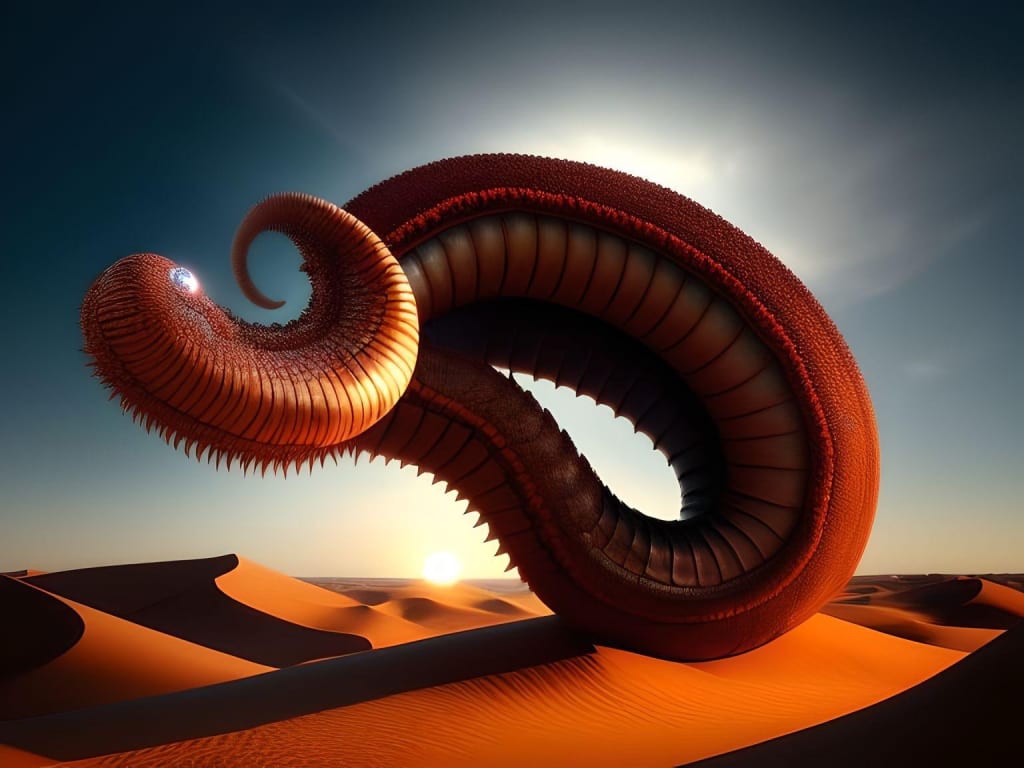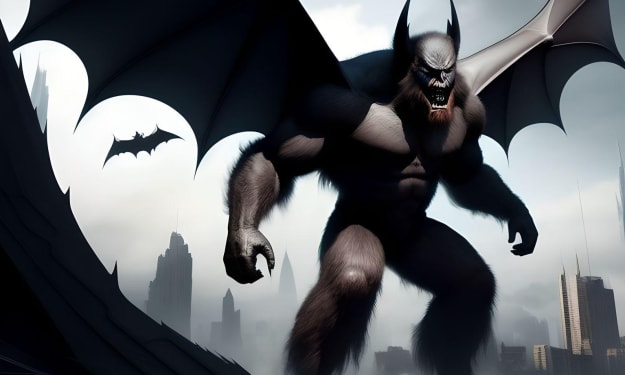The Mongolian Death Worm: A Sandy Expedition into the World of Cryptids
It’s Just a Really Big Worm… I Think…

Just when you think that I might start running out of elusive and mysterious creatures to talk about, I’ve got another one for your inquisitive pleasure. This one is said to roam Mongolia while evading scientific proof and baffling cryptozoologists everywhere. Today I’m going to dive into one of the lesser-known yet equally fascinating cryptids: the Mongolian Death Worm.
Now, before you start picturing a giant worm with a scythe and a black hood, let me clarify that the nickname "Death Worm" is not entirely accurate. The Mongolian Death Worm, or Allghoi khorkhoi in the native language, is a creature said to inhabit the Gobi Desert. It's described as a sausage-like worm, around two to five feet long, with no discernible head or tail. Think of it as a sand-dwelling, carnivorous pool noodle with a penchant for destruction.
A Legend is Born
The legend of the Mongolian Death Worm dates back to at least the early 20th century, although some claim its origins go back even further. It's said that the worm's very touch is lethal, and that it can spew forth corrosive venom or even shoot lightning from its body. Now, I don't know about you, but I'm picturing something akin to the lovechild of a graboid from "Tremors" and a Pokémon.
Despite its fearsome reputation, the Death Worm is considered a taboo subject among the locals. Some believe that even speaking of the creature will bring misfortune, while others simply dismiss it as a silly superstition. However, this hasn't stopped intrepid explorers and cryptozoologists from seeking out the truth behind this enigmatic beast.
In Search of the Elusive Worm
Over the years, numerous expeditions have been launched to find evidence of the Mongolian Death Worm's existence. One of the earliest and most famous searches was led by Czech explorer Ivan Mackerle in 1990. Mackerle, who was clearly not one to shy away from a challenge, embarked on a two-month journey through the Gobi Desert, armed with little more than a few camels, some enthusiastic companions, and an unyielding determination to uncover the truth.
Unfortunately, despite Mackerle's best efforts, the expedition failed to produce any concrete evidence of the Death Worm. While they did encounter some locals who claimed to have seen the creature, these accounts were largely anecdotal and could not be independently verified. Thus, the mystery of the Mongolian Death Worm persisted.
In the years that followed, several other expeditions would attempt to unravel the enigma of the Death Worm, but with similarly disappointing results. Some researchers even tried using various technological devices, such as ground-penetrating radar and infrared cameras, in the hopes of detecting the elusive cryptid. Alas, the Death Worm remained as elusive as ever, leading many to question its very existence.
Science Weighs In
Skeptics argue that the Mongolian Death Worm is nothing more than a myth, borne out of fear and superstition. They point to the lack of physical evidence, such as carcasses or shed skins, as proof that the creature is merely a figment of the imagination. Additionally, some scientists have suggested that the Death Worm could be a misidentified species of snake or legless lizard, rather than a unique cryptid.
On the other hand, proponents of the Death Worm's existence argue that the Gobi Desert is a vast and inhospitable place, making it entirely possible for an undiscovered creature to remain hidden from the prying eyes of science. They also point to the fact that new species are discovered all the time, even in well-studied environments, which lends some credence to the possibility that the Death Worm could be more than just a legend.
So, what's the verdict? Is the Mongolian Death Worm a genuine cryptid, or simply a tall tale spun by superstitious desert-dwellers? The truth remains as elusive as the creature itself, but one thing is certain: the legend of the Death Worm has captured the imaginations of people all over the world, and its enduring popularity shows no signs of waning.
The Cultural Impact of the Mongolian Death Worm
While the Mongolian Death Worm may not enjoy the same level of global recognition as Bigfoot or the Loch Ness Monster, it has nevertheless left its mark on popular culture. The creature has been featured in various books, movies, and television shows, often portrayed as a terrifying monster with a penchant for devouring hapless victims.
Perhaps the most famous example of the Death Worm in popular culture is the 2010 Syfy original movie, "Mongolian Death Worm." This cinematic masterpiece (and I use that term loosely) tells the story of a group of treasure hunters who unwittingly unleash the wrath of the eponymous creature while searching for a legendary lost tomb. As you might expect, chaos and carnage ensue, with the Death Worm displaying an impressive array of deadly abilities, including spitting acid and generating electrical shocks. The film was met with mixed reviews, but it did succeed in introducing the Mongolian Death Worm to a wider audience.
Even video games have gotten in on the Death Worm action, with several titles incorporating the creature into their gameplay. For example, the popular mobile game "Death Worm" allows players to take control of a massive, man-eating worm, wreaking havoc on unsuspecting humans and vehicles alike. While the game's worm bears little resemblance to the legendary Mongolian Death Worm, it undoubtedly draws inspiration from the cryptid's fearsome reputation.
The Future of the Mongolian Death Worm
As long as there are unexplored corners of the Earth and enigmatic creatures lurking in the shadows, the allure of cryptids like the Mongolian Death Worm will continue to captivate our imaginations. Will we ever uncover definitive proof of the Death Worm's existence, or will it remain forever shrouded in mystery and folklore? Only time will tell.
In the meantime, the legend of the Mongolian Death Worm serves as a reminder that our world is still filled with wonder and the unknown. It's a testament to the power of human curiosity and our unquenchable thirst for knowledge, even in the face of seemingly insurmountable odds. Until then, keep your eyes peeled and your wits about you when traversing the Gobi Desert – you never know what might be lurking just beneath the sands.
About the Creator
Heather N King
Meet the mistress of words who weaves tales that transport you to other worlds. With a unique perspective and a gift for storytelling, my writing will leave you spellbound and craving more.
Reader insights
Outstanding
Excellent work. Looking forward to reading more!
Top insights
On-point and relevant
Writing reflected the title & theme
Easy to read and follow
Well-structured & engaging content
Expert insights and opinions
Arguments were carefully researched and presented
Eye opening
Niche topic & fresh perspectives
Compelling and original writing
Creative use of language & vocab
Heartfelt and relatable
The story invoked strong personal emotions
Excellent storytelling
Original narrative & well developed characters
Masterful proofreading
Zero grammar & spelling mistakes






Comments (3)
This Mongolian Death Worm reminded me of the Alaskan Bull Worm from Spongebob, lol! I enjoyed reading this!
Love these. I knew a little about this one, not much, but you really displayed all the information I needed on the worm really well! I really enjoy the touch of humor you sprinkle in there too, keeps me wanting more, really enjoying myself throughout.
I getting Dune vibes 😁